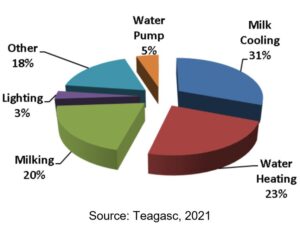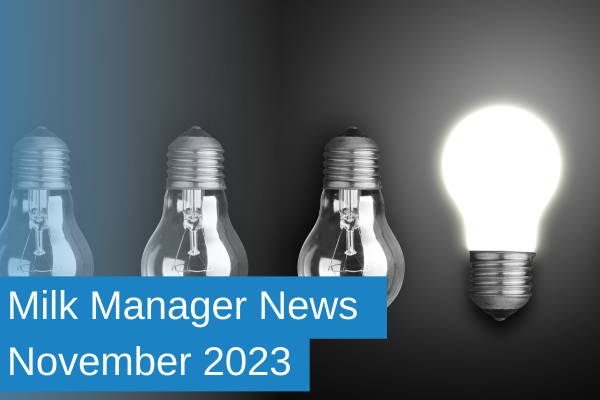MMN November 2023 – Reducing Energy Costs on Dairy Farms
10 November 2023Electricity typically represents 4% of a dairy farm’s variable costs (AHDB, 2021). The main areas of energy consumption are milk cooling (31%), water heating (23%) and the milking machine (20%) (Figure 1). Understanding where and how energy can be reduced in these areas can result in significant savings.
Figure 1. Average electricity component consumption (60 commercial dairy farms)

Variable speed drive for the milking vacuum
Vacuum pumps can consume between 20-25% of all electricity used on dairy farms. Vacuum pumps are least efficient when the vacuum level increases, therefore farmers should ensure their vacuum is running at the correct level to conserve energy. Installing a variable speed vacuum pump can reduce energy consumption by 40-50% through altering the motor speed, and running at the lowest output needed for adequate vacuum for the milking system (Penn State, 2023). Moreover, through lower RPMs of the vacuum pump it is possible to extend its lifetime and have lower maintenance and oil costs.
Recover heat from milk coolers
There may be an opportunity to transfer heat energy generated from milk cooling to heat up water. Dairy Heat Recovery Units (HRU) use the ‘waste’ heat released from the milk cooling units to heat water. A HRU can raise the temperature of water up to 60°C, which can offer a saving of between 30-70% of heating costs. The warm water can have multiple uses, including washing down the parlour, feeding calves or heating up water in troughs. In a study by Petersen et al. (2016), cows drinking warm water as opposed to cold water drank 30% more (cold water = 8.2°C, warm water = 31.1°C) which could help drive higher milk production.
Plate coolers
The temperature of milk needs to drop from 37°C to 4°C within 30 minutes of milking, which is an energy demanding process. Plate coolers can be fitted prior to the bulk tank to help reduce the milk temperature. Plate coolers are metal plates which run parallel to each other with cold water running in the alternate direction to the milk. A plate cooler can reduce the temperature of the milk down to 10-20°C before entering the bulk tank, which can reduce milk cooling costs by up to 50%. AHDB studies (2023) found that a 200-cow herd producing 1.6 million litres of milk annually with a plate cooler installed could save 20,666 kWh of electricity, which equates to just over £2,000 per annum.
Tariffs
Farmers should maximise the use of lower rate electricity tariffs. AHDB claim that an appropriate tariff and good timer control offers the biggest savings and quickest payback. It is possible for savings to exceed 15%, particularly for a first-time tariff mover.
Lighting
There are many types of bulbs available for lighting which vary in terms of light output in regard to energy consumption. If light bulbs were 100% efficient all electric would be converted to light with no heat production. Generally, LED bulbs are 90% efficient, compact fluorescent lamp (CFL) bulbs 85% efficient, but incandescent bulbs are only 10% efficient. Therefore, farmers should look to replace inefficient light sources with those which are more efficient and result in better task lighting.
Consider the following four areas to help reduce electricity costs on dairy farms:
- Install a variable speed drive for vacuum pumps.
- Recycle ‘waste’ heat from milk coolers.
- Using a plate cooler to drop milk temperature before it enters the bulk tank.
- Review tariffs and opt to utilise energy at lower night-time tariffs.
- Consider replacing inefficient lighting.
References available upon request.
Olivia Ward, olivia.ward@sac.co.uk; 01539 769059
Sign up to the FAS newsletter
Receive updates on news, events and publications from Scotland’s Farm Advisory Service

